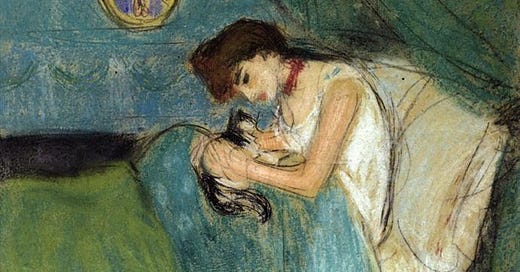Pablo Picasso has been written in history for the sharp, angular and strange cubist style that he and fellow artists created in the early 1900s. A style that, when I was younger, made me think of him as a harsh artist -- not necessarily a creator of peace or objective beauty. But, hidden beneath years of cubist works, there is another Picasso. In his early years, the artist had a rich history of experimenting with various art forms. In Woman with Cat, painted at just 19-years-old, Picasso’s more delicate artistic side holds a small space in his story.
I’m not a super-fan of animated movies but, in my mind, the Aristocats takes the cake. The soft blues, greens and roses of that film are striking in a subtle way. I see it in stark contrast to Disney movies today – those that use bright colors and overstimulation to keep an audience entranced. Woman with Cat, though much older than the Aristocats, shares its fluidity, curves, and soft colors that may fly under the radar until looked at more closely. “Beautiful things don’t ask for attention.”
Blues and greens are known to be the most calming paint colors. The woman is comfortable amongst the curved lines of the plush bedspread and pillows. These features may have been employed by Picasso to attune us to the woman’s location. She’s in a home, and a feeling of safety is present. The intimacy of the bedroom and personal interaction between woman and cat, the curvature of the bedspread, and the pop of red around the woman’s neck make the captured thought or memory seem quite private. Whether it’s her own room, Picasso’s, or another’s, I wonder if this scene was something created entirely in the artist’s head, or if he was a witness to such an intimate moment.
I can see Picasso seated behind the canvas, drawing this woman as the moonlight sifts in from an unseen window. Maybe they’ve shared an evening together, before drifting upstairs for sleep. I imagine Picasso, at the young age of 19, seeing a beautiful moment and wanting to document its serenity. He pulls out his art supplies from a weathered leather bag, scattering them across a windowsill. Taking his rough sketchbook into his hand, he sets to work – the slow-rolling conversation shifting to an intimate silence hanging in the air as he focuses on her outline.
In this painting, the young artist draws our eyes to the woman and circular portrait on the wall through a use of lighter shades. The two stand out against the rich, deep colors of the thick, quality fabrics surrounding them. It may just be me, but Picasso may have added a touch of boyish humor and lightness to this scene with his depiction of the man on the wall. Though aesthetic with his brown curly hair, purple suitcoat, and yellow tie, he seems to be sticking out his tongue. Maybe he’s meant to be goofy. The portrait and the girl are bright and full of life in the midst of this shadowy, evening scene that shows every intention to provide a space to settle down for the night. Even the cat is enveloped in the darkness of the sheets, seemingly less important than the face of the man on the wall. We are left to wonder who he may be.
There isn’t much information offered online about this pastel drawing. Picasso has created many other cubist works featuring women with cats that have garnered more attention and information. Painted before Picasso’s blue and rose periods, and currently privately-owned, Woman with Cat seems to be a bit lost in the past. Though maybe this is okay. Part of the magic of this piece is in its mystery. Whether intended or accidental, here Picasso leaves space for the viewer to create in their own mind, along with him, as they fill in the gaps of the story.





Lovely article Sam. It is so well written and I can actually hear your voice as I am reading the article. Love your choice of words and your presentation.
As commented on earlier articles you have written, your choice of descriptive words draws the reader in and creates increased interest in your writings.